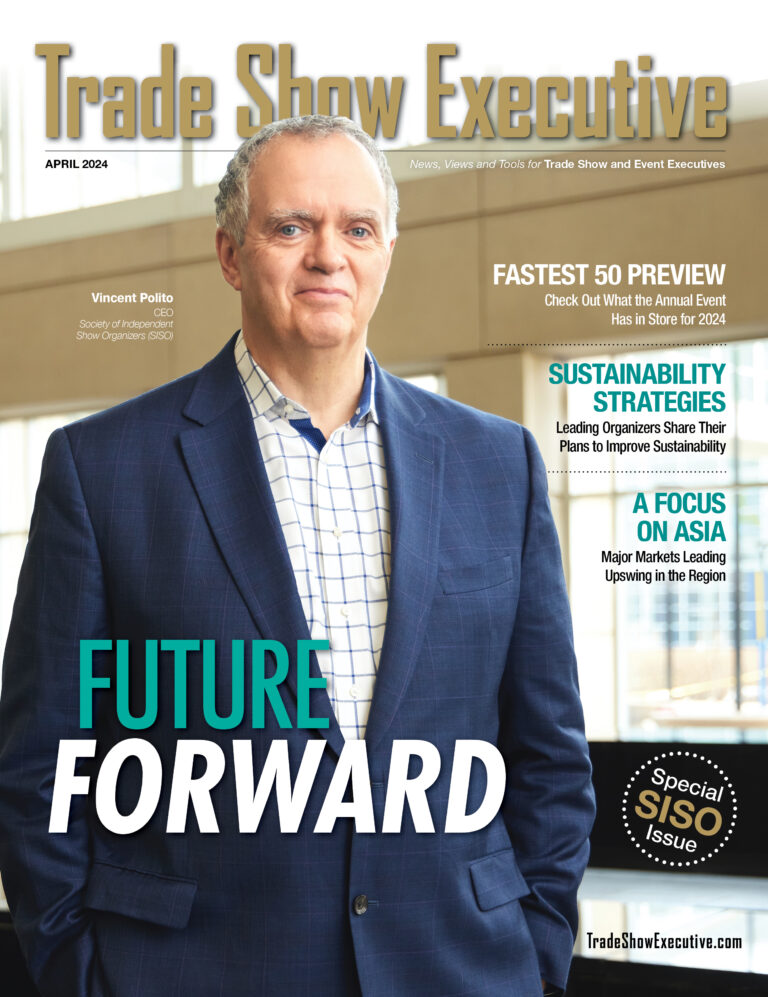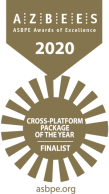Mike Rusbridge is chairman and CEO of Reed Exhibitions Worldwide, based in Richmond, Surrey, UK. He joined the company in 1979 and became managing director of Cahners Exhibition Group, Ltd. (part of Reed Elsevier) in 1982, chief executive of Reed Exhibitions Europe in 1988, president of Reed Exhibitions Europe and Asia in 1994, and chairman of Reed Exhibitions Worldwide in 1996. He has guided the company to unparalleled global success, overseeing a dramatic expansion of Reed’s presence in the emerging BRIC economies (Brazil, Russia, India and China) as well as in the Middle East and Latin America. We spoke two days before he left for a safari to Zambia with his family.
Bob: Reed Exhibitions Worldwide has experienced phenomenal growth under your leadership. How have you structured the company to achieve this?
Mike: First and foremost, we are comprised of local teams serving local markets, which need to be quick, adaptive and entrepreneurial. Our competition is often not from other large organizers, but rather from local and national companies. We have regional presidents covering the world, reporting to me, as well as offices in 39 countries with 2,600 employees running 500 shows.
Bob: What is your revenue breakdown, vis-à-vis organic growth, acquisitions and launches?
Mike: Revenue increased 42% over the last four years. That breaks down to 38% organic growth, 12% launch, 15% acquisition and 23% going the other way – divested business.
Bob: Do you have an in-house “Incubator Team” for acquisitions?
Mike: We have a central team here that acts as a filter for 20,or 40 different properties that we are constantly evaluating, which includes financial, legal, etc. In the majority of cases, however, the management teams around the world drive our acquisitions – it’s truly a “flow up” system. We average about 8 to 10 acquisitions a year, investing between U.S.$150 to 200 million annually.
Bob: What about entering new markets or territories?
Mike: A team that reports to our commercial director does the bigger deals here and I get involved with final approval.
Bob: What do your look for primarily?
Mike: We’re after a strategic fit with the 47 industry sectors where we have developed – or are developing – a global event network. We acquire for the long term, unlike many businesses funded by venture capital, which look for a three to five-year return. We look as far out as we can, comforted by Reed Elsevier’s financial backing. We are constantly seeking high quality, market-leading events with good sustainable growth as well as excellent management.
Bob: How important is the management team in an acquisition?
Mike: One of the things that could be a deal breaker is the quality of the management team and whether they will stay on board. I would be less interested in an event or company if we felt that within six months, we could lose those people who developed that business and have the market reputation, knowledge and intelligence. We have been very fortunate in most of our acquisitions to retain the management. Also, I am always interested in opportunities where we can add to our own management team.
Bob: What about your launches? How quickly can you tap into a new market opportunity?
Mike: Ideally, we look at a minimum launch time of 12 months out, but preferably 18 months out. We have launched a few shows in six months’ time to gain a competitive edge or when our research identified a strong immediate need.
Bob: How many shows do you launch each year?
Mike: Historically, we have launched between 30 to 40 new shows a year. This year, we’re probably going to launch 25 to 28 events that will come from our show teams in particular markets. Approximately 50% will be brand extensions. We’re also looking seriously at green themes.
Bob: Can you give an example of a brand extension in a new region?
Mike: Virtually our entire manufacturing portfolio has been migrated to Asia or the BRIC economies. We now have 40 events in China, including electronic manufacturing, packaging and others that began elsewhere. We’ve done this by tracking major industry shifts and moved our events accordingly. Timing used to be quite flexible, but today’s window for accepting an event is quite precise.
Bob: I have observed that this migration has been integral to your success over the years.
Mike: Looking at the West, meaning the U.S. and Europe, versus the rest of the world, Asia and the BRIC countries were 9% of our total business 10 years ago. Today, they are over 20% and will grow to 30% within the next few years. Another part of our success is the ability to see things multi-dimensionally and define what industry sectors and geographies we want to be in and then create events where our skills match these goals. I think we’re good at doing this.
Bob: What are the main global challenges to Reed Exhibitions today?
Mike: Being in 47 industry sectors and 38 countries gives you a greater resilience to the vagaries of the economy. Short of everything being down, as it was back in 2002 to 2003 when we had the unholy trinity of a global economic downturn, a war and terrorism – oh yes, and SARS – you simply cannot buck that trend completely. For example, we are more resilient to what’s happening today in America, due to compensating higher growth from markets in Brazil, China and the Middle East. Our blend has contributed to our double-digit revenue growth. We are just nudging a turnover of U.S.$1.4 billion on a management basis.
Bob: That’s amazing for our industry.
Mike: The quality and depth of our management has fueled and sustained this kind of growth and I’m really very proud of all of our people. We also made our customers the focus of our business; we try to stay very close to their needs in the marketplace. Our service levels are being greatly enhanced, with such additions as the “Mystery Shopper” program, our Exhibitor University and several other innovations. Clearly, what’s happening online is another challenge and we’ve set ourselves a goal of driving U.S.$100 million in e-revenue.
Bob: Reed Elsevier recently put its print business on the block. Has it been sold?
Mike: It is in the process of being divested.
Bob: Do you think other media companies will follow Reed’s example and sell off their print business?
Mike: I think it all depends on a company’s strategy. Print is a very good business but it just didn’t fit the future strategy of Reed Elsevier.
Bob: How would you sum up that strategy?
Mike: They are looking at market-leading positions, high-growth opportunities, global positions, providing solutions and online opportunities. Reed Exhibitions doesn’t fit the latter online category, but we are definitely market-leading, high-growth, global and solutions-oriented. This is why we were retained.
Bob: What are the challenges with your online offerings?
Mike: We have about 400 websites, some of which are good and others are “not quite there.” We are adding online directories and improving functionality around those. We’re developing vertical industry portals with three or four underway. We are looking at platform solutions and acquisitions. In the last 12 months, we’ve built an impressive team of in-house professionals to move us forward with greater confidence.
Bob: Audience involvement today is generally a combination of face-to-face, print and online. With the sale of Reed’s print business, how will that affect media coverage of your events?
Mike: Interestingly, most of our shows were not associated with Reed Elsevier publications. We always had the freedom to choose among publishers. Historically, there has been no favoritism with the Reed publications and vice versa – we embrace everyone in our communities and sectors.
Bob: Regarding the economy, do you feel that exhibitions are a lagging indicator of economic health?
Mike: I think that it’s historically true: “last in, last out.” By that I mean companies tend to book space 12 or even 24 months in advance, so our industry tends to feel the impact a little later than print and comes out of these cycles a bit later. Of course Reed Exhibitions will be impacted but we are taking steps to minimize this. I also believe we are much more resilient than we were 10 years ago.
Bob: Do you feel the competition has changed given the current economic climate in the West?
Mike: Again, I’m sure that most of my colleagues would agree that in tougher economic times, the money follows the market-leading events. This situation is like freezing water in a rock: it will find the weak spots and expose them. If you are not close to your customers or your value proposition is not in line with the market, you are going to find out about it very quickly. We don’t sell real estate anymore; we sell marketing solutions, responding to strategic imperatives of our customers. Building a good solution for them may be including exhibit space, but increasingly it is a multiple platform that responds to what they hope to achieve. Personalized solutions are the new norm.
Bob: What are you doing to help exhibitors deal with escalating costs associated with exhibitions?
Mike: Several things: we leverage our buying power for our customer’s benefit. We advise them on how to participate, looking at exhibit packages to further reduce their total cost. By staying close to customers, we are better able to provide solutions that do not necessarily involve increasing their real estate imprint. More and more, our exhibitors come to us for assistance with their global marketing programs – and that’s wonderful. In essence, their global trade is intertwined with our exhibitions.
Bob: Do you still manage association-owned shows?
Mike: Yes, but less than we used to. We have management contracts but more often partnerships and joint ventures. Depending on where you are in the world, they are very important to entry into a marketplace and event success.
Bob: How do you identify and develop future leaders within Reed Exhibitions?
Mike: We are spending more time developing our management team and enhancing their career paths. Our first requirement for any growth is to have managers available to handle it successfully. We have a variety of programs within certain skill areas, and we take advantage of Reed Elsevier’s many management programs. We also send people to advanced courses at schools such as Harvard University.
Bob: Who were your mentors along the way?
Mike: I would say that I enjoyed working with or for quite a number of fine people over the years, whether they were at Clapp & Poliak, Cahners, Reed Exhibitions or Reed Elsevier. You pick up great skills and knowledge – and things not to do – from all of these contributors over the years.
Bob: What advice would you give a middle-management trade show executive?
Mike: The trade show industry worldwide is a multi-billion dollar industry comprised of talented people but they often wouldn’t have known about the business if they hadn’t fallen into it. It’s fast-growing and exciting with enormous potential for career growth. We need more of those kinds of people and we need them to stay once they join us. It’s quite a multi-faceted industry today, and we are hiring people who “don’t look like us”, i.e. those with different specialist skill sets. I’ve enjoyed my time in the industry and highly commend it to those already here and those considering joining us.
Bob: What keeps you up at night?
Mike: It’s dangerous to make the statements I’m about to make, as comments like these have a nasty habit of coming back to bite one in the future. That said, as far as I see Reed Exhibitions and our industry right now, there isn’t anything out there to upset our momentum. What potentially could impact us springs from our own internal management challenges, i.e. enough of the right people to manage our growth. Mind you, I’m very focused on any possible Achilles’ Heel, knowing that it could come from within as well as from outside. One of our strengths is that we have “stuck to our knitting” and executed well on what we know best. Right now, the challenge is being able to maintain our growth levels and doubling our business down the road.
Reach Mike Rusbridge at +44 208 910 7901 or mike.rusbridge@reedexpo.co.uk
Bob Dallmeyer is Past Chairman of both the International Association of Exhibitions and Events (IAEE) and the Trade Show Exhibitors Association (TSEA), as well as a former Director of the Center for Exhibition Industry Research (CEIR). In 2006, he was inducted into the Convention Industry Council’s “Hall of Leaders.” Reach Bob at (323)934-8300 or bdallmeyer@tradeshowexecutive.com











